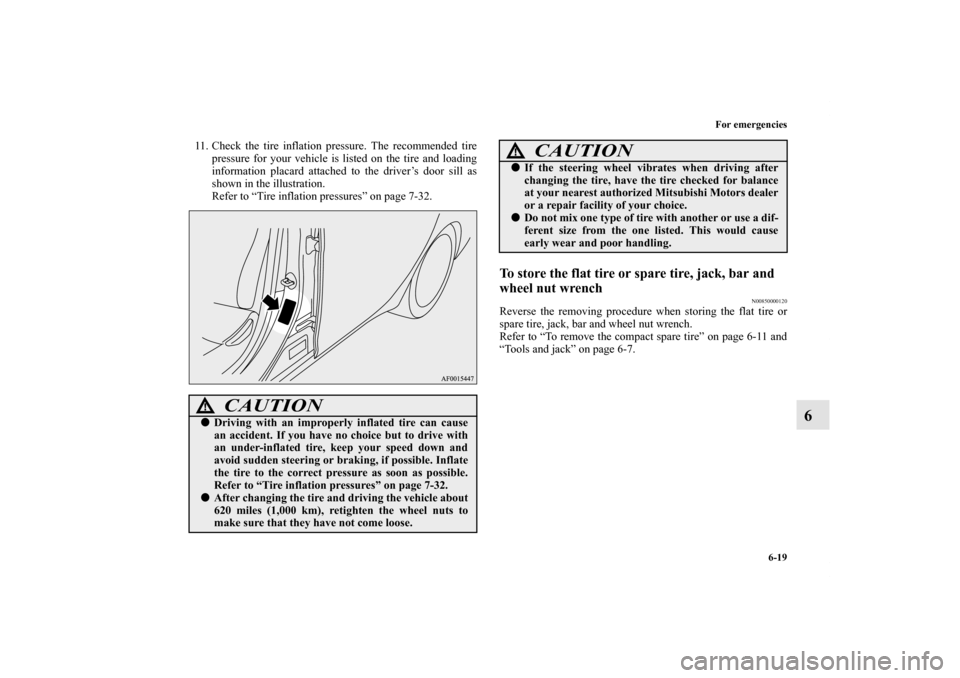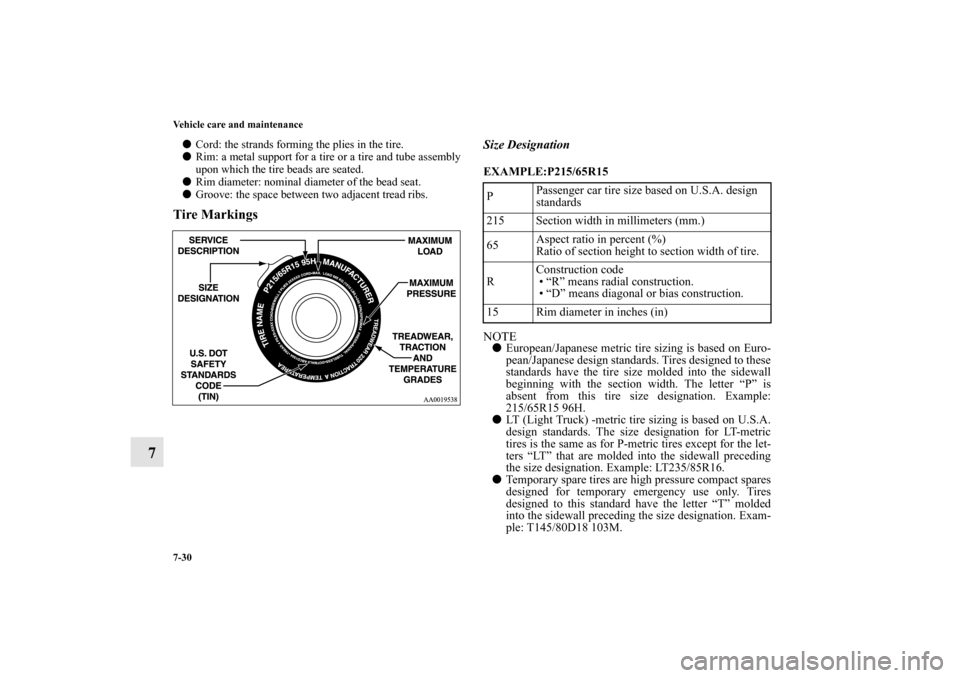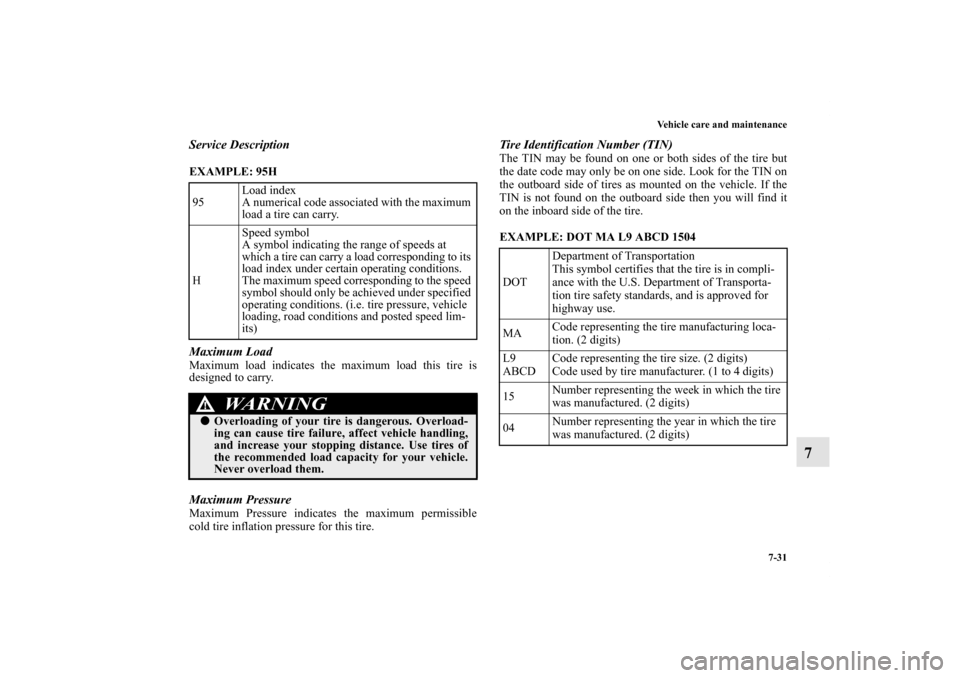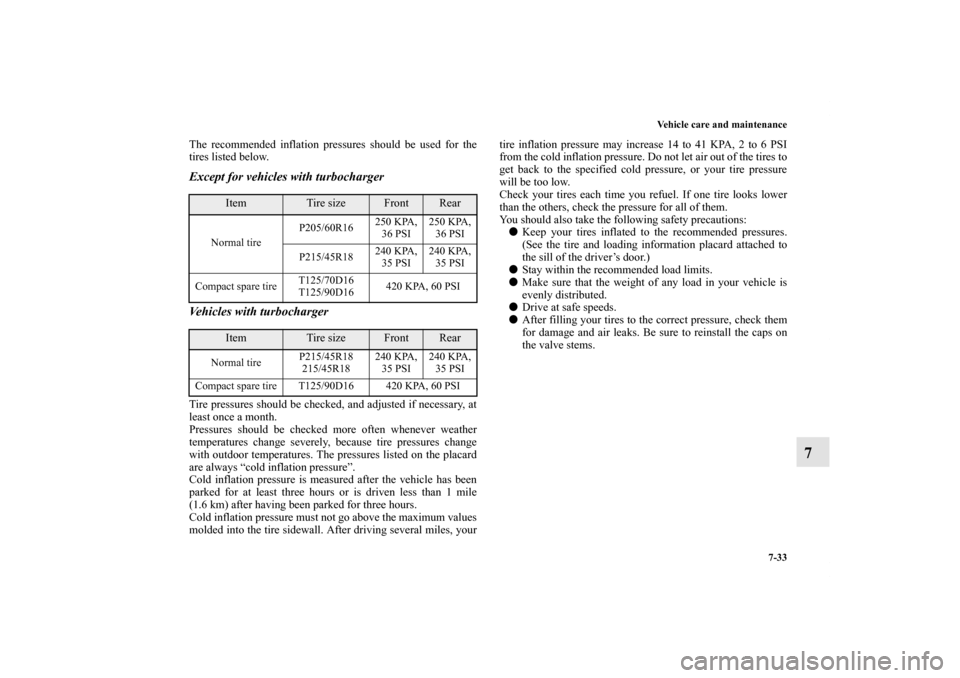Page 408 of 722

Driving safety
4-7
4
�Check the engine antifreeze.
If there is not enough coolant because of a leak or from
engine overheating, add Dia Queen Super Long Life
Coolant Premium or equivalent.
Please read this section in conjunction with the “Engine
coolant” on page 7-12.
[For RALLIART vehicles sold in U.S.A.]
�Mitsubishi Motors recommends that the standard equip-
ment tires be replaced with winter tires when the vehicle
is going to be used in winter.
The standard equipment tires provided with this vehicle
are summer tires and use a high-grip compound that pro-
vides superior grip.
The road grip, however, is reduced in winter.
When replacing the standard equipment tires with winter
tires, all four tires must be replaced using radial identical-
size winter tires.NOTE�As your vehicle is equipped with a tire pressure monitor-
ing system, there is a risk of damage to the tire inflation
pressure sensors when the tire is replaced on the rim. Tire
replacement should, therefore, be performed only by an
authorized Mitsubishi Motors dealer.�If you use new wheels with new tire inflation pressure
sensors, their ID codes must be programmed into the tire
pressure monitoring system. Refer to “Whenever the tires
and wheels are replaced with new ones” on page 3-171.
WA R N I N G
!�Never open the radiator cap when the radiator is
hot. You could be seriously burned.
BK0138600US.book 7 ページ 2011年7月17日 日曜日 午後2時32分
Page 412 of 722
Driving safety
4-11
4
This placard shows the maximum number of occupants permit-
ted to ride in your vehicle as well as “the combined weight of
occupants and cargo” (A), which is called the vehicle capacity
weight. The weight of roof road is included in the definition of
“cargo” when determining the vehicle capacity weight. This
placard also tells you the size and recommended inflation pres-
sure for the original equipment tires on your vehicle. For more
information, refer to “Tires” on page 7-29.
Ty p e 1
Ty p e 2
BK0138600US.book 11 ページ 2011年7月17日 日曜日 午後2時32分
Page 583 of 722
6-12 For emergencies
6
2. To remove the spare tire, remove the installation clamp
(C) by turning it counterclockwise.NOTE�The clamp cannot be used for a normal size tire. Store a
normal size tire under the luggage floor board.
NOTE�Put the spare tire under the vehicle body near the jack.
This makes it safer if the jack slips out of position.
BK0138600US.book 12 ページ 2011年7月17日 日曜日 午後2時32分
Page 590 of 722

For emergencies
6-19
6
11. Check the tire inflation pressure. The recommended tire
pressure for your vehicle is listed on the tire and loading
information placard attached to the driver’s door sill as
shown in the illustration.
Refer to “Tire inflation pressures” on page 7-32.
To store the flat tire or spare tire, jack, bar and
wheel nut wrench
N00850000120
Reverse the removing procedure when storing the flat tire or
spare tire, jack, bar and wheel nut wrench.
Refer to “To remove the compact spare tire” on page 6-11 and
“Tools and jack” on page 6-7.
CAUTION
!�Driving with an improperly inflated tire can cause
an accident. If you have no choice but to drive with
an under-inflated tire, keep your speed down and
avoid sudden steering or braking, if possible. Inflate
the tire to the correct pressure as soon as possible.
Refer to “Tire inflation pressures” on page 7-32.�After changing the tire and driving the vehicle about
620 miles (1,000 km), retighten the wheel nuts to
make sure that they have not come loose.
�If the steering wheel vibrates when driving after
changing the tire, have the tire checked for balance
at your nearest authorized Mitsubishi Motors dealer
or a repair facility of your choice. �Do not mix one type of tire with another or use a dif-
ferent size from the one listed. This would cause
early wear and poor handling.
CAUTION
!
BK0138600US.book 19 ページ 2011年7月17日 日曜日 午後2時32分
Page 627 of 722

7-30 Vehicle care and maintenance
7
�Cord: the strands forming the plies in the tire.
�Rim: a metal support for a tire or a tire and tube assembly
upon which the tire beads are seated.
�Rim diameter: nominal diameter of the bead seat.
�Groove: the space between two adjacent tread ribs.Tire Markings
Size DesignationEXAMPLE:P215/65R15
NOTE�European/Japanese metric tire sizing is based on Euro-
pean/Japanese design standards. Tires designed to these
standards have the tire size molded into the sidewall
beginning with the section width. The letter “P” is
absent from this tire size designation. Example:
215/65R15 96H.
�LT (Light Truck) -metric tire sizing is based on U.S.A.
design standards. The size designation for LT-metric
tires is the same as for P-metric tires except for the let-
ters “LT” that are molded into the sidewall preceding
the size designation. Example: LT235/85R16.
�Temporary spare tires are high pressure compact spares
designed for temporary emergency use only. Tires
designed to this standard have the letter “T” molded
into the sidewall preceding the size designation. Exam-
ple: T145/80D18 103M.PPassenger car tire size based on U.S.A. design
standards
215 Section width in millimeters (mm.)
65Aspect ratio in percent (%)
Ratio of section height to section width of tire.
RConstruction code
• “R” means radial construction.
• “D” means diagonal or bias construction.
15 Rim diameter in inches (in)
BK0138600US.book 30 ページ 2011年7月17日 日曜日 午後2時32分
Page 628 of 722

Vehicle care and maintenance
7-31
7
Service DescriptionEXAMPLE: 95H
Maximum LoadMaximum load indicates the maximum load this tire is
designed to carry.Maximum PressureMaximum Pressure indicates the maximum permissible
cold tire inflation pressure for this tire.
Tire Identification Number (TIN)The TIN may be found on one or both sides of the tire but
the date code may only be on one side. Look for the TIN on
the outboard side of tires as mounted on the vehicle. If the
TIN is not found on the outboard side then you will find it
on the inboard side of the tire.
EXAMPLE: DOT MA L9 ABCD 1504
95Load index
A numerical code associated with the maximum
load a tire can carry.
HSpeed symbol
A symbol indicating the range of speeds at
which a tire can carry a load corresponding to its
load index under certain operating conditions.
The maximum speed corresponding to the speed
symbol should only be achieved under specified
operating conditions. (i.e. tire pressure, vehicle
loading, road conditions and posted speed lim-
its)
WA R N I N G
!�Overloading of your tire is dangerous. Overload-
ing can cause tire failure, affect vehicle handling,
and increase your stopping distance. Use tires of
the recommended load capacity for your vehicle.
Never overload them.
DOTDepartment of Transportation
This symbol certifies that the tire is in compli-
ance with the U.S. Department of Transporta-
tion tire safety standards, and is approved for
highway use.
MACode representing the tire manufacturing loca-
tion. (2 digits)
L9
ABCDCode representing the tire size. (2 digits)
Code used by tire manufacturer. (1 to 4 digits)
15Number representing the week in which the tire
was manufactured. (2 digits)
04Number representing the year in which the tire
was manufactured. (2 digits)
BK0138600US.book 31 ページ 2011年7月17日 日曜日 午後2時32分
Page 630 of 722

Vehicle care and maintenance
7-33
7
The recommended inflation pressures should be used for the
tires listed below.Except for vehicles with turbocharger
Vehicles with turbochargerTire pressures should be checked, and adjusted if necessary, at
least once a month.
Pressures should be checked more often whenever weather
temperatures change severely, because tire pressures change
with outdoor temperatures. The pressures listed on the placard
are always “cold inflation pressure”.
Cold inflation pressure is measured after the vehicle has been
parked for at least three hours or is driven less than 1 mile
(1.6 km) after having been parked for three hours.
Cold inflation pressure must not go above the maximum values
molded into the tire sidewall. After driving several miles, yourtire inflation pressure may increase 14 to 41 KPA, 2 to 6 PSI
from the cold inflation pressure. Do not let air out of the tires to
get back to the specified cold pressure, or your tire pressure
will be too low.
Check your tires each time you refuel. If one tire looks lower
than the others, check the pressure for all of them.
You should also take the following safety precautions:
�Keep your tires inflated to the recommended pressures.
(See the tire and loading information placard attached to
the sill of the driver’s door.)
�Stay within the recommended load limits.
�Make sure that the weight of any load in your vehicle is
evenly distributed.
�Drive at safe speeds.
�After filling your tires to the correct pressure, check them
for damage and air leaks. Be sure to reinstall the caps on
the valve stems.
Item
Tire size
Front
Rear
Normal tireP205/60R16250 KPA,
36 PSI250 KPA,
36 PSI
P215/45R18240 KPA,
35 PSI240 KPA,
35 PSI
Compact spare tire T125/70D16
T125/90D16420 KPA, 60 PSI
Item
Tire size
Front
Rear
Normal tireP215/45R18
215/45R18240 KPA,
35 PSI240 KPA,
35 PSI
Compact spare tire T125/90D16 420 KPA, 60 PSI
BK0138600US.book 33 ページ 2011年7月17日 日曜日 午後2時32分
Page 631 of 722

7-34 Vehicle care and maintenance
7
Replacing tires and wheels
N00939600368
Tire maintenance
N00939700154
The following maintenance steps are recommended:
�Check tire pressures regularly.
�Have regular maintenance done on the wheel balance and
front and rear suspension alignment.
�Rotate your tires regularly as described in the “Tire rota-
tion” section on page 7-35.
CAUTION
!�Avoid using different size tires and wheels from the
ones listed, and avoid the combined use of different
types of tires and wheels. Using different size or type
tires and wheels may affect driving safety.
Refer to “Tires and wheels” on page 9-9.�For All-wheel drive vehicles, always use tires of the
same size, same type, and same brand, and which
have no wear differences. Using tires that differ in
size, type, brand or the degree of wear, will increase
the differential oil temperature, resulting in possible
damage to the driving system. Further, the drive
train will be subjected to excessive loading, possibly
leading to oil leakage, component seizure, or other
serious problems.�Even if a wheel has the same rim size and offset as
the specified type of wheel, its shape may prevent it
from being fitted correctly. Consult an authorized
Mitsubishi Motors dealer or a repair facility of your
choice before using wheels that you have.�Only Mitsubishi Motors genuine wheels should be
used, because your vehicle is equipped with a tire
pressure monitoring system.
Use of another type of wheel risks air leaks and sen-
sor damage, as it will not be possible to install the
tire pressure sensor properly.
BK0138600US.book 34 ページ 2011年7月17日 日曜日 午後2時32分